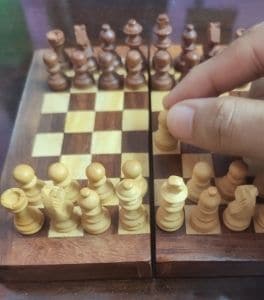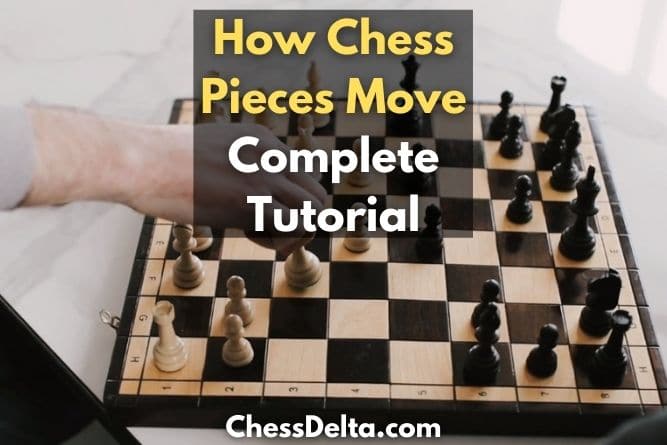You might have heard the word “checkmate” a lot of times.
But do you what does checkmate exactly means in chess? What are the rules of checkmate?
Interested to know all these? Then you are in the right place!
In this article, I am going to explain to you everything regarding checkmate from start to finish, along with rules and all the related questions.
Although checkmate might be easy for you, its rules will confuse you a lot if you don’t understand it properly.
Keeping that in mind, I have prepared this article for you such that you understand everything very easily.
So make sure you read till the end! Let’s start!
Table of Contents
What is checkmate in chess?
In simple words, checkmate means a player’s king is under attack and there is no way left to get out of it. So if you are in checkmate, then that means your king is in threat and you have no way left to save it from your opponent’s attack.
To understand checkmate see the below example.
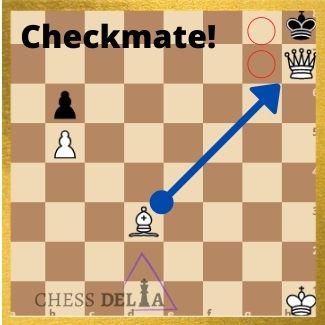
Here the black king is attacked by the white queen so there is no way left to get out of the attack.
Even the black king can’t take the white queen because it is supported by the white bishop. So this is the condition of the checkmate.
Read More: Can A King Kill A Queen In Chess?
Remember, a checkmate is different from a check because when the king is under check there is still some hope of taking it out of the danger zone.
But when you get checkmated, it simply means ‘the end’, provided the move made is legal.
To understand checkmate more thoroughly you can watch this video on Coach Dat YouTube Channel.
Now you may wonder if it is possible to checkmate without check, then the answer is yes. To know more you can read my in-depth article Can You Checkmate Without Check? (Explained With Examples!)
So after having a clear idea about what is checkmate, let’s see the checkmate rules.
What are the rules of checkmate?
#1. Checkmate immediately ends the game
Checkmate immediately ends the game provided the move made to produce it was a legal one.
You may be wondering what is a legal and illegal move. Right?
Nothing, just any move that follows the standard rules of chess is said to be a legal move and that doesn’t follow, is known as an illegal move.
For more information on this, check out my detailed article: What Do You Mean By Illegal Moves In Chess? Along With Examples!
#2. A player getting checkmated loses the game
A player who gets checkmated loses and the player who checkmates the opponent wins the game. It is as simple as that.
There’s nothing to say about this rule. So let’s move on to the next rule.
#3. A game is drawn if no player can checkmate
If neither of the two players can checkmate each other then this condition is known as a ‘Draw’ in chess.
Now there are many ways a draw can occur in a chess game.
But when neither player can checkmate the other by any series of legal moves then that position is termed as a ‘dead position’.
The condition is called a ‘draw due to insufficient mating material’.
For example, if you only have a king left, while your opponent has a king and bishop.
Then, in such a case, there are no positions in which your opponent can checkmate you. (Because your opponent doesn’t have enough pieces to checkmate)
So the game ends in a draw.
This also occurs when you both have only the king left.
Read More: What Happens If Only The King Is Left In Chess?
Another type of draw that you need to know is stalemate.
The stalemate means the king is not in check (and can’t be checkmated), also the player has no legal moves left to continue the game further.
So the game ends in a draw. To know more read my article: Stalemate Vs Checkmate: A Helpful Guide For Beginners!
#4. A game is drawn if the opponent can’t checkmate after time runs out
If you checkmate and think you will win the game then in professional games this is not the case always.
A player loses if he or she runs out of time. But if the opponent cannot checkmate that player by any series of legal moves then in that case the game is drawn.
Now when a player runs out of time he/she loses the game.
But if the situation of the board is such the opponent of that player could not checkmate that player had the game continued, then the opponent has no right to win on time.
So simple the game ends in a draw.
I have discussed this in detail in my article What Happens When Chess Clock Runs Out? (With Rules) which you can check out for further reference.
Now, if you are not familiar with professional chess games, you may think why I’m talking about the time in chess, right?
Actually, all professional chess games are time-controlled. This prevents professional chess games to continue for long hours unnecessarily.
In casual games, clocks are not used but in tournament games, a clock is a must.
Don’t worry if you don’t have a physical chess clock available to play with your family members or friends in a professional style.
There are chess clock apps for this purpose which you can check out in my article: Top 10 Best (Free) Chess Clock Apps Detailed Reviewed
#5. A game is drawn if the opponent can’t checkmate after the second illegal move
As per the FIDE article 7.5.5, if a player makes an illegal move for the first time then his or her opponent is allotted two minutes extra times as a penalty.
But for the second time if the player again makes an illegal move then the arbiter (referee) of the game will declare the game as a draw.
However, as I discussed with you if the situation of the board is such that the opponent cannot deliver checkmate by any series of legal moves then the game is drawn.
Also Read: Difference Between Stalemate And Draw In Chess
#6. A king can’t checkmate another king directly
A king cannot capture or checkmate another king in chess in a direct way. Moreover one cannot put his or her king into check deliberately.
These two things are related.
First of all, you need to understand that a game of chess ends at the point when the king is in threat and there is no legal way left to take it out of that threat.
This is known as checkmate, right?
Now the point is when one king tries to capture or checkmate another king it has to approach next to it.
But the moment that king approaches next to it it becomes an illegal move because you cannot put your own king in check intentionally.

Hence, due to this both kings can never checkmate each other.
However, there are indirect ways to checkmate another king with your king.
I have talked more about all these in my in-depth guide on Can A King Capture Or Checkmate Another King? (Explained) So you can check out for further information.
#7. A pinned piece can check as well as checkmate
Now, this rule may confuse you a little bit so read with attention, especially if you are a newbie.
So as per the FIDE article 3.9.1, a king is considered to be in check even if it is attacked by the pieces which are constrained to move from their place because otherwise their own king will be exposed to check.
In chess, there is a concept of ‘pin’ which means a chess piece is (pinned) constrained in its place and can’t move because a more valuable piece behind it will get exposed to attack.
Here I’m discussing the case where the more valuable piece is the king.
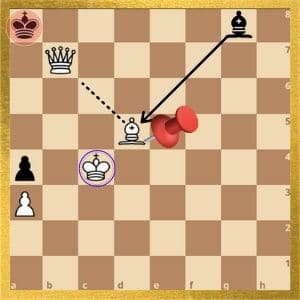
This is a position in which the black king is checkmated and here’s why.
The black king is attacked by the white queen. And it can’t move away to get out of the threat because there are no safe squares available.
Neither another piece can be placed between it and the white queen.
So the only option that remains is to kill the white queen. But is it possible? The answer is no! Because the white queen is guarded by the white bishop.
Thus, even though the white bishop is also pinned as you can see, still involves in the checkmate.
To get a more in-depth explanation of this check out my article: Can A Pinned Piece Give Check And Involve In A Checkmate? (Explained)
So these are the important checkmate rules in chess you need to know.
These rules are in accordance with the FIDE Laws Of Chess. FIDE (or the World Chess Federation) is the international body that connects the national chess federations and governs international chess competitions.
Now as I told you, a chess game is won by the player who checkmates his/her opponent. So after knowing what is checkmate and what its important rules are, time for action?
How amazing it would be if you could just checkmate your opponent in a few moves, let’s say within 2 moves, right? So let’s discuss that!
How do I checkmate in 2 moves?
To checkmate in 2 moves you need to have the black chess piece and the first two moves of your opponent having the white chess piece must be such that the white king gets exposed to attack easily. This type of checkmate is known as a fool’s mate.
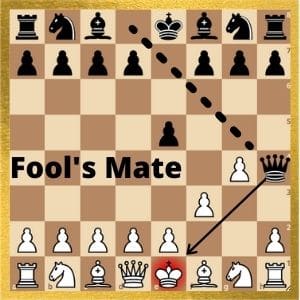
Move 1: White pawn (of an opponent) to f2 square. In response to (your) Black pawn to e5 square.
Move 2: White pawn to g4 square, further opening up the diagonal and making it more vulnerable. Black responds to this and takes the advantage of the weakness of the white king, and checkmates by moving the queen h4 square.
This is how you can checkmate in 2 moves.
Note that if in the first move, white moves the white pawn on g4 square instead of f2 square and on the second move, moves the white pawn on f4 square instead of g4, rest everything remains the same then that is considered a variation of this fool’s mate pattern (also called as Grob’s attack)
Read More: How To Win Chess In 2 Moves?
Now, you may be amazed to know this pattern but actually, this happens very rarely in real games unless your opponent makes a serious blunder.
However, it is good to know this, who knows you may get a chance and show your chess skills?
Also Read: Can You Checkmate With Two Bishops? (Yes, Here’s How!)
What happens if you say checkmate and it’s not?
Nothing. The game continues as normal as if nothing happened. There is no standard rule mentioned regarding this type of situation. However, it is good to avoid such mistakes, especially in professional tournament games because this may distract your opponent.
There are rules as per which a player has the right to complain to the arbiter (referee) if his or her opponent distracts him by making unnecessary noise.
I have already written a detailed article on this topic: What Happens If You Falsely Call Checkmate? Do You Lose? (Explained)
In that, I have also shared an incident of a player who experienced this situation in real life. Check that out for further reference.
Conclusion
So that’s it! 🙂 Hope you found this article helpful and valuable. Bookmark this tab or add this to your home screen so that you can revisit it as and when required. Thanks!
Wait! Don’t forget to check out my recommendations on Top 15 Funny Chess Gift Ideas That Will Make You Smile!
Related Questions:
How does checkmate work in chess?
Whenever a player’s king is under attack in such a way that there is no way to get out of it then the player is said to be checkmated. If the move is legal then the player who checkmates wins the game. While the player who gets checkmated loses the game.
How many checks are allowed in chess?
There is no theoretical limit on the number of checks. But there are standard rules in chess such as the threefold repetition rule and the 50 move rule that prevent the player to continue the game by giving repeated checks.
You can read more about this in my article: How Many Checks Are Allowed In Chess? (Explained)
Is checkmate the only way to win chess?
No, apart from checkmate, also there are ways to win a game such as when a player runs out of time when a player resigns, and when a player makes two illegal moves.
Read my article: 3 Ways To Win Chess Other Than Checkmate! to know more

